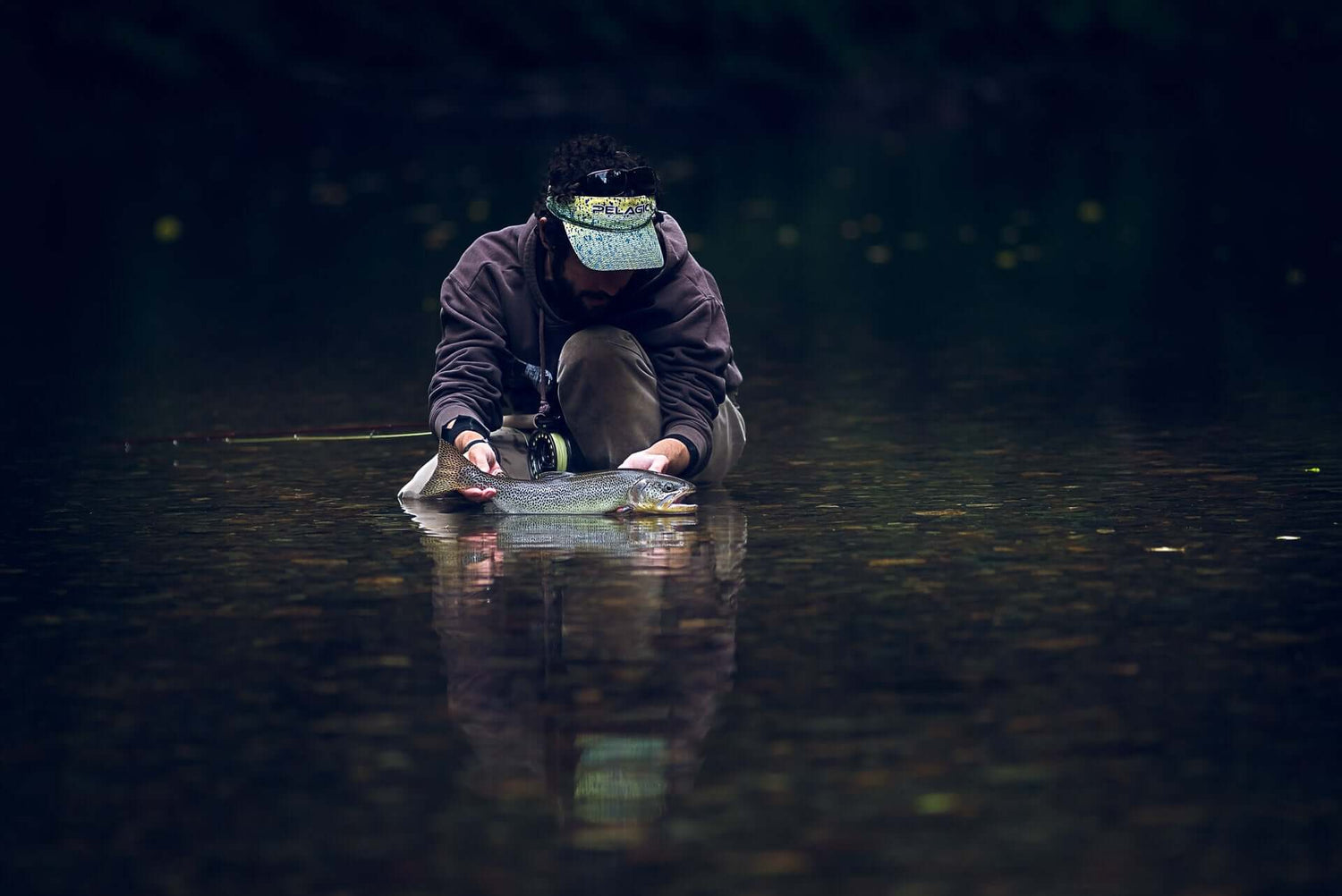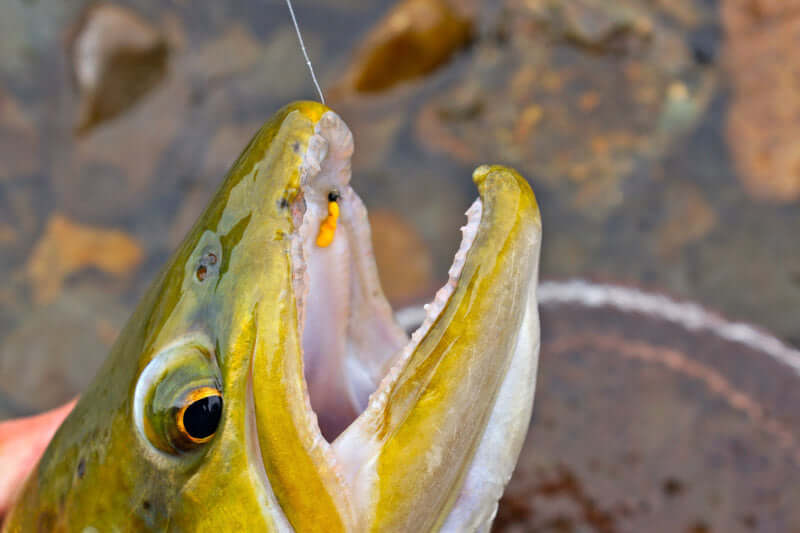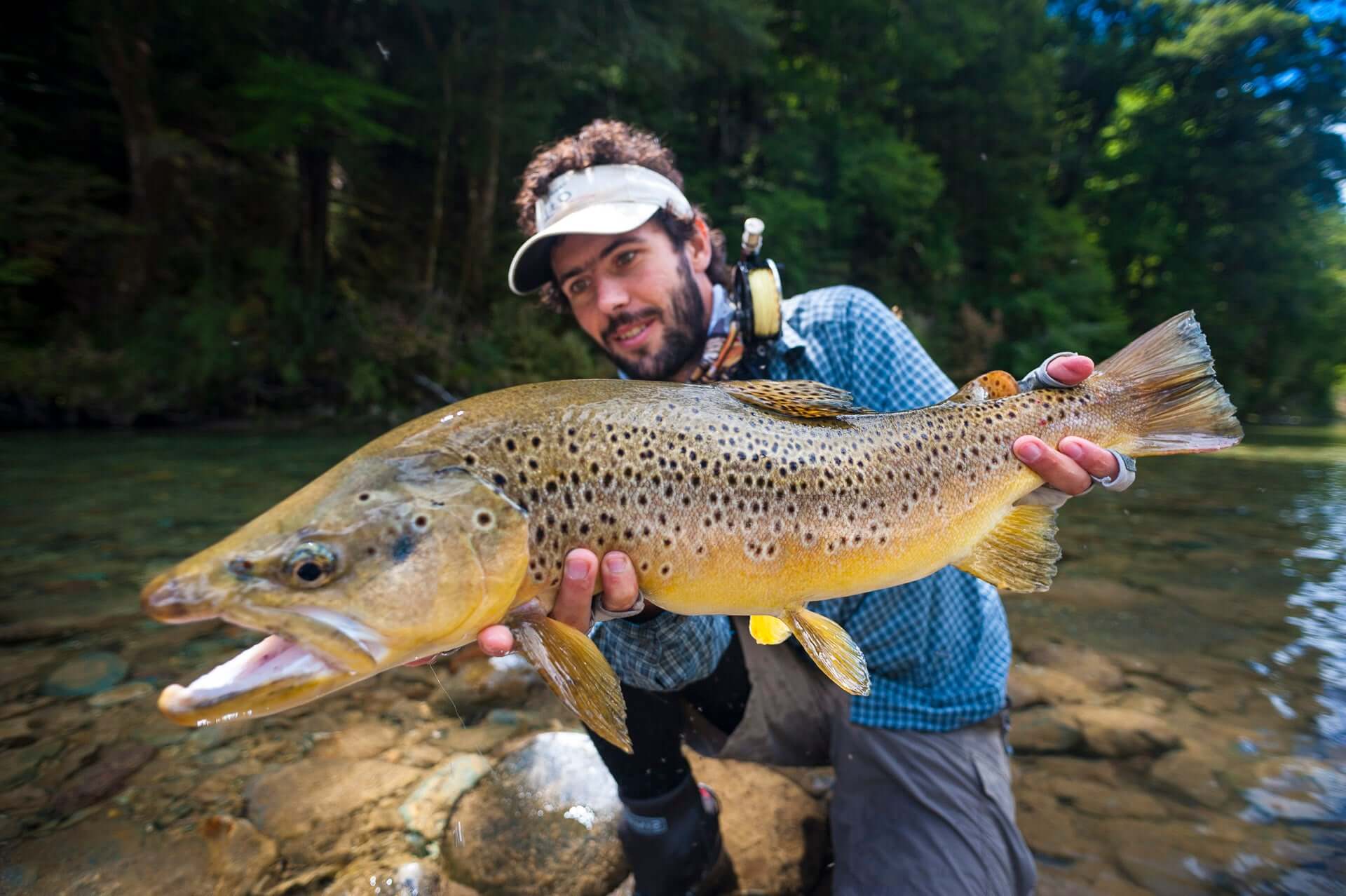A Weighty Problem! Winter Grayling Blog by Dave Southall
It’s the traditional grayling season with Autumn mists, frosts & cold water. Although there’s a chance of grayling rising to aphids in November & tiny midges throughout the winter, most of their feeding is likely to be close to the riverbed. Furthermore, as the water gets colder, & their metabolic rates slow down, the fish become less inclined to inhabit the faster, shallow water & are more likely to be found in the deeper water where the flows are more leisurely. As a result weighted nymphs, shrimps & grayling bugs will most likely be required to tempt the fish. In November they may well be prepared to rise to take a nymph fished at mid-water, but by Christmas our offerings are best presented close to the riverbed.
Our flies are going to need some ballast to get them quickly into the fishing zone. That nearly certainly means the use of tungsten and/or lead.
|
Materials |
DENSITY grams per cm3 |
|
Tungsten |
19.35 |
|
Lead |
11.35 |
|
Copper |
8.96 |
|
Brass (alloy of copper and zinc) |
8.73 |
The use of metal beads is now standard practice when tying heavy sub-surface flies. Gold Head or Pearl Head flies incorporating glass beads were used over 100 years ago in Northern Italy. Roman Moser tells how in 1978 he was given some Pearl Head flies by a Tyrolean friend which prompted him to use gold brass beads in his nymphs as additional weight and thus the “Gold Head” was invented. In 1981 Moser bent some size 12 and 14 soft wire hooks with pliers to produce Micro jigs with a lead shot super glued behind the eye and then coated with gold varnish. In the USA Ed Sisty introduced bead head nymphs to his readers as early as 1972 when he published his book “Ed Sisty’s New Professional Methods in Tying Nymphs”. In my opinion, tungsten beads are the best for tying flies to fish deep & it is now possible to purchase them in a wide range of sizes/weights, colours & designs.
Counter-sunk beads have a hole running through the middle with a cone-shaped recess at the rear to aid threading round the hook bend. If the hole is not too big then they are some of the heaviest beads for their size & are available right down to 1.5mm diameter. However, some have rather big central holes & can pull over the eyes of some hooks. Furthermore, they do not act as a keel so flies tend to fish hook point down making them prone to snagging on the riverbed.
Slotted beads, when used with Jig hooks, have the advantage of making the fly fish point upwards, thus reducing the problems of snagging up on the riverbed. They come in two versions, narrow slot & normal slot. The narrow slotted beads are heavier for their size, but can be impossible to thread onto thick-wired jig hooks. Since quite a bit of metal has been removed to facilitate fitting them onto a hook they tend to be lighter than equivalent sized counter-sunk beads.
Jig-off beads are rapidly becoming my favourites. They are pear-shaped with an off-set hole at the narrower end & a slight recess on the front into which the hook eye sits. Their biggest advantages are that they can be used with standard hooks, including Grub hooks & they will act as a keel to make them fish point upwards, plus they are the heaviest beads for their size. They are also easy to thread onto any hooks, including Jig hooks. They are not easy to find in their full range of sizes (2mm to 4.5mm) & colours & I’ve had to search some of the European suppliers.
Tungsten Bidoz/Shrimp Bodies are useful for tying really fast-sinking shrimp/Gammarus/Scud imitations that fish point upwards. They are very heavy & have a slot into which the hook shank can be super-glued. I tie mine with CdC fibers tied into split thread: then wound as a palmered hackle: after which I fold the CdC down, apply super glue to the top & glue on the body, which is finally fully locked in place with a rib of 0.18mm diameter wire. A coating of UV resin on the back can further resist wear & tear from bumping along the riverbed.
Tungsten Jig Backs are similar to the Bidoz Bodies & can be used for Heptageneid nymph imitations & Grayling Bugs.
Coloured Tungsten Collars can be used behind countersunk beads to provide a ‘hot spot’ & extra weight.
As mentioned weights of these beads & bodies vary considerably & some suppliers provide the actual weights.
Bidoz Tungsten Shrimp Bodies (taken from the Bidoz website)
|
LENGTH mm |
WEIGHT grams |
SUGGESTED HOOK SIZES |
|
5 |
0.10 |
20/22 |
|
6 |
0.15 |
18/20 |
|
7 |
0.17? |
16/18 |
|
8 |
0.28 |
14/16 |
|
9 |
0.50 |
12/14 |
|
10 |
0.90 |
10/12 |
Tungsten Jig Backs
|
SIZE |
LENGTH mm |
WEIGHT grams |
SUGGESTED GRUB HOOK SIZE |
|
Small |
7.0 |
0.28 |
16 |
|
Medium |
7.6 |
0.36 |
14 |
|
Large |
8.9 |
0.54 |
12 |
|
X-Large |
10.4 |
0.98 |
8 & 10 |
Tungsten-Beads-Plus Countersunk Tungsten Beads
|
DIAMETER mm |
WEIGHT grams |
|
1.5 |
0.020 |
|
2 |
0.055 |
|
2.5 |
0.100 |
|
3 |
0.200 |
|
3.5 |
0.310 |
|
4 |
0.460 |
|
4.5 |
0.580 |
|
5.5 |
1.000 |
Jig Off Bead Weights (Troutline)
|
DIAMETER mm |
WEIGHT grams |
|
2.3 |
0.10 |
|
2.8 |
0.20 |
|
3.3 |
0.33 |
|
4.0 |
0.53 |
Additional weight can be added to flies by the use of lead wire or lead strip under-bodies, copper wire ribs and wire bodies, rubber sheet impregnated with tungsten powder & heavy-wire hooks.
The sinking rate of flies depends not only on how heavy the fly is but on a range of other factors which include:
The surface area of the fly. Fat or spiky/buggy flies will sink more slowly than slim, smooth-bodied patterns.
Tippet diameter. Thicker tippet with its larger surface area will slow down a fly’s sink-rate.
Tippet material. Fluorocarbon has a density of around 1.3 g per cm3 & that of copolymer is around 1.15 g per cm3, so in theory fluorocarbon should sink a fraction faster than copolymer of the same diameter. In practice although both are more dense than water they both tend to float due to grease from anglers’ fingers (even a steel needle can be made to float if well greased and silk lines with a density of around 1.3 g per cm3 will float if treated with a suitable hydrophobic floatant).
Whether the tippet is degreased. As mentioned grease on the line will resist sinking, so treating the tippet with sinkant will aid sinking (I use a mix of Fullers Earth, Fairy Liquid and Glycerine rubbed onto the line).
Whether there is slack in the tippet when the fly lands. Dump/Parachute Casts that pile tippet on top of where the fly lands will aid sinking.
The water’s speed. Faster surface flows will slow down the sink rate of the fly as they will try to drag the fly up & away from the slower subsurface flows. So flies will tend to sink more slowly in faster water. This is particularly so if thick leader butts or fly line are floating on the faster surface water.
The angle of cast relative to the water’s flow. Casting across or downstream will tend to slow down the sink rate unless there is plenty of slack in the tippet when the fly lands.
Whether the fly is fished singly or part of a team. Many nymph fishers fish a team of two or three flies, usually with the heaviest on the point to drag the smaller, lighter flies down. There is certainly an advantage to this as the lighter flies will move more naturally as they are more easily influenced by nuances of the subsurface currents.
Whether split shot is added to the line. I sometimes use split shot on the point to sink lighter nymphs/bugs, or to drag on the river bed/lake bed to slow down the drift. This is useful when there is a ‘one fly only’ rule or when the bottom is very snaggy (a split shot will relatively easily pull off the tippet when snagged on the bottom, avoiding the loss of tippet & flies).
How do I fish my heavy grayling flies? Much depends on the circumstances. However since grayling are far more tollerant of a close approach than trout, I generally fish at close range with as long a rod & as light a line as possible so I have maximun control of my presentation. My favoured setup is the 10’ 2 weight Sunray Volition (now superceeded by the Microlite 10’ 2 weight & 10’ 6” 3 weight), teamed up with A Sunray Micronymph line or 1 weight Sunray Jeremy Lucas line to which I attach a 7 to 8’ taper cut from a 12’ tapered leader (tapering from 0.43mm to about 0.20mm) with a small perfection loop at the end to which I can attach tippet or a semi-curly tricoloured indicator & tippet. This allows me the flexibility to use a wide range of tactics from Euro-nymphing methods, Floating Indicator-nymphing methods, Duo/ New Zealand Dropper style nymphing, Sight-nymphing & Dry Fly.
In fast-water areas where the surface flow is significantly faster than the subsurface flow I much prefer short-line Euro-nymphing/High Sticking with a Semi-curly coloured monofilament indicator held above the fast water with tippet lengths about 1.5x the water depth & only the fine tippet exposed to the drag from the fast surface water. Typically I’ll have a relatively heavy fly on the point, just occassionally touching bottom & a smaller/lighter fly on a dropper about 12”/30cm or a little more above. Casting upstream at about 45 degrees and tracking the rod till the flies are downstream & the current starts to lift them, I’ll then gently lift & lob them back upstream on a slightly different line, searching all the likely water. This method used with either a long conventional rod or Tenkara rod ensures minimal drag from the fast surface water. As long as the rod is tracked at the right speed so there is no slack in the system, takes are clearly indicated by the indicator either stopping or the slight coils stretching out. Sometimes these indications are the point fly catching on the riverbed but any indication should be responded to by a smooth lift. If it is not a fish, as long as one hasn’t lifted violently, the drift can be continued. It can help to give frequent small lifts during the drift to induce a take & to help avoid too many hook-ups on the bottom. Some folks prefer a straight coloured mono or braid indicator since it lets them feel their flies bump the bottom & in some cases feel bites, but I like the bit of slack provided by the semi-curly indicator as I feel the fish are less likely to feel any resistance when taking the fly.
A quick alternative to the mono indicator, if I want to change between dry fly & nymphing is to apply a coating of soft, fluorescent Neon Wax to the thicker part of the leader setup, just above the tippet. I use bands of white, green & red. When finished with it is easily wiped off the leader & is equally easy to reapply.
In slower, smooth flows I prefer the use of a New Zealand Wool Indicator greased up with Lineslick or brushed with Fumed Silica powder. A loop of leader/tippet is pulled through a short length of fine-bore silicone tube using a baiting needle with an open eye at the tip: then a piece of greased wool is inserted into the loop & pulled back into the tubing. The amount of wool can be adjusted to support a range of fly weights & the depth can be easily adjusted so that the fly/flies will fish at the correct depth.
On my local chalk stream, Driffield Beck, I mainly sight-fish, just watching the target fish for the slightest sign that it has taken my fly (an opened mouth, a flare of the pectoral fins, a change of position followed by a stop). This is undoubtedly my favourite way to target subsurface-feeding grayling.
Although my prefered method of fishing is dry fly, there is no doubting the value of weighted flies when fishing for winter grayling, or for very big grayling which rarely rise to dry flies on many waters (I’ve only ever caught 2 grayling over 2lb on Driffield Beck, but many more including several over 3lb on heavy weighted flies).

Bidoz/Shrimp Bodies, Slotted Beads, a Tungsten Collar & a Jig Back

Bidoz & CdC Shrimps

Tungsten bead & Wire body Perdigon nymph

Tungsten bead & Lead body nymph

New Zealand Wool Indicator, Loon Biostrike Floating Putty Indicator & Semi-curly Tricoloured Mono Indicator

A nice grayling caught on a heavy nymph
































